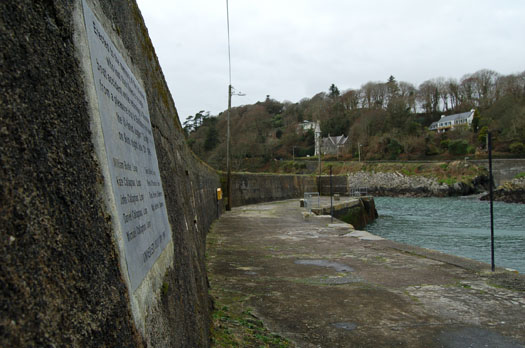#glandoreharbour – I have had good times, as well as tough and challenging sailing and one frightening experience in the harbour of the oaks or the harbour of gold. Those descriptions, some locals claim, are literal meanings of the name, Glandore, one of my favourite boating spots on the West Cork coastline.
I was there one August Sunday night many years ago when a gale that was not forecast whipped in from the South. Glandore can be a difficult place in strong Southerlies. Met Eireann had forecast a lovely Bank Holiday Weekend that year, but they were completely wrong and later admitted it. We spent a tough night in the Sadler 25 I had at the time. Our anchor pulled out, our inflatable protected us from dragging onto the boat behind and we got the engine started, then spent an hour or two motoring against the gale to keep ourselves clear of the mayhem which was developing elsewhere in the harbour as holiday-making sailors found themselves in the worst of conditions. Tossed around in the heavy winds and pounding waves, we got ourselves across to the westerly side of the harbour and went to anchor in a more passive location off Union Hall until the wind force spent itself, which didn't happen for several hours..
For a while, it was frightening.
That night came to my memory a few weeks back walking along the pier at Glandore on a bright afternoon, when I stopped to look at a plaque recessed into the wall, which is easy to pass by without taking too much notice. That would happen, particularly when the inner harbour enclosed by the pier, is busy.
There is another plaque, partnering the one at Glandore in the village of Leap, a few miles away from Glandore, on the main Cork-Skibbereen road. The plaque is at the Quay Cross in the village and recalls when a party of people travelled from Leap onto Glandore, heading for a day's sail to Baltimore, to the west of Glandore.
Some of them never travelled that way again when they died in the tragedy of the 44ft. fishing lugger, the Zenith.

Glandore Pier and the plaque on the wall marking the loss of the Zenith in 1895
The Glandore plaque lists the names of those who had travelled that roadway in high spirits, looking forward to a summer sea trip around the coast. Baltimore could be more pleasantly reached in the year 1895 by water than by road.
In those days it was regular enough on the West Cork coastline to travel by boat from one coastal village to another for a few hours of relaxation during the summer. Roads were not good. Travel by water in the calm weather of July 1895, on a flat sea, would be more pleasant than the sixteen miles by road. Such a trip, "an excursion" was a change from daily working life and was eagerly looked forward to.
It was about nine o'clock on the Sunday summer's night, July 28, 1895 when the group which had sailed from Glandore earlier in the day to Baltimore for their outing boarded the Zenith for the return journey and they were in good form. Some porter had been drunk by the men, the ladies and children had taken lemonade and some of them were now beginning to feel the chill in the air that creeps aboard a boat at sea as the sun goes down and the cloak of night begins to draw a curtain across the sky. It would be dark when they reached Glandore because the wind was very light. But there was no great concern aboard. It was suggested that the fire in the cabin should be lit to provide a bit of warmth for those who might like to go below and that tea should be made, particularly for the ladies and children aboard.
That fire caused the subsequent disaster when it burned through the wooden boat.
There were 23 in the "excursion party" with six crew. Nine died. Sherkin Islanders, fishermen and the Coast Guard rescued the survivors after they managed to get ashore from a punt towed by the lugger, others scrambling onto rocks when ther drove the Zenith ashore by rowing, while it was still burning.
The subsequent inquest heard denials that anyone aboard was under the influence of alcohol, which police confirmed. The Coroner concluded that the use of paraffin oil to light the fire in the boat's cabin had caused the tragedy, although the Skipper said it had been used throughout the season and had never given trouble before, not even on the voyage from Glandore to Baltimore when it had also been lit.
"We always use paraffin oil in kindling the fire. It is no way dangerous when used in small quantities," Skipper John Hamilton told the inquest.
It was disclosed that the boat did not have any protection between the stove and the bulkhead, such as a sheet of iron which it was stated, was used in other boats. The Coroner said his conclusion was that paraffin should not be used in lighting a fire on board.
The rocks of Adam and Eve guard, or make the entrance to Glandore challenging, depending upon your viewpoint, but of the many times I have landed by inflatable or punt onto Glandore Pier, I had never noticed the plaque to the Zenith until that afternoon walk along the pier.
In these times when politicians could show more commitment to the maritime sphere and the fishing industry, another aspect of Glandore's history recalls that James Redmond Barry, who bought Glandore Estate in 1823, was then the Member of Parliament for the area. He is credited with driving the development of Glandore Pier, the installation of harbour navigation marks and the fishing industry, including a boat building industry in the village across the harbour from Glandore - Union Hall.
Glandore Harbour Yacht Club was founded in 1985. It is particularly associated with the Dragon fleet, but also has cruisers, Dragons, Squibs and other dinghies. The village gets particularly busy during the influx of holidaymakers in Summer, when ISA training programmes and a sailing programme for local schools are run. GHYC now has its own club house. Glandore Regatta which dates back to 1830 is a major event held in August. So is the biennial Classic Regatta held in July, at which I have had great enjoyment sailing over several years. It was first held in 1992 and has developed into an outstanding event where the masterpieces of the great age of sail mingle with traditional West Cork sailing workboats and many other classics for a week of sailing and spectacle. The Glandore Maritime Summer School, held in alternate years, is a great occasion for marine discussion and lectures.
If you haven't taken note of the Zenith plaque, take a look the next time you are on Glandore Pier, or in Leap village.
It is a reminder of how close tragedy can be to pleasure on the water and a message about the importance of safety at sea to all of us.
Until next week, the usual wish of ..... "fair sailing" ........
Twitter: @Tom MacSweeney































































